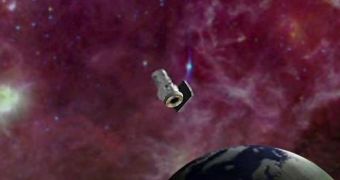NASA officials announce that the space agency's latest telescope, the Wide-field Infrared Survey Explore (WISE) instrument, has finished undergoing preparations, and is currently set for a Friday, November 20, roll-out date. The observatory has been chilled to its operating temperature, and has already been outfitted with its sunshade, which will prevent light from the Sun, Earth or Moon from getting into its ultra-sensitive detectors. The rocket carrying WISE will lift off at around 6:09 am PST (1409 GMT) on December 9, from the Vandenberg Air Force Base, in California.
“The eyes of Wise are a vast improvement over those of past infrared surveys. We will find millions of objects that have never been seen before,” Edward Wright, the principal investigator of the new mission, explains. The expert holds an appointment with the University of California in Los Angeles (UCLA). Because the telescope will be cooled to very low temperatures, it will be able to observe things like “cold” stars, dark asteroids and the most luminous galaxies, experts at the Pasadena, California-based NASA Jet Propulsion Laboratory (JPL) announce.
“This is an exciting time for space telescopes. Many of the telescopes will work together, each contributing different pieces to some of the most intriguing puzzles in our universe,” Jon Morse adds. He is the NASA Astrophysics Division director, at the agency's headquarters, in Washington, DC. The sensitivity of the new observations will be hundreds to hundreds of thousands of times greater than that of its predecessors, its builders say, and millions of new objects could be discovered because of this.
Other observatories, including NASA's Hubble and Spitzer Space Telescopes, the European Space Agency's (ESA) Herschel Space Observatory, and NASA's upcoming Sofia and James Webb Space Telescope, will follow up on WISE's finds. The new instrument will map the entire sky using four infrared wavelengths, the American space agency reports. “With infrared, we can find the dark asteroids other surveys have missed and learn about the whole population. Are they mostly big, small, fluffy or hard?” JPL Wise project scientist Peter Eisenhardt says.
“Wise is chilled out. We've finished freezing the hydrogen that fills two tanks surrounding the science instrument. We're ready to explore the universe in infrared,” JPL Project Manager William Irace adds. He explains that, in order to be effective, WISE's instruments will be cooled almost to absolute zero. The coldest of these devices will operate at about 8 degrees Kelvin, or minus 445 degrees Fahrenheit.

 14 DAY TRIAL //
14 DAY TRIAL //